Create high quality UGC - Try Showcase for free
Closing 181 Youtubers for Your Brand [A COMPLETE GUIDE]
By David Morneau
16 min READ | Apr 12 2019
![Closing 181 Youtubers for Your Brand [A COMPLETE GUIDE]](png/closing-181-youtubers-for-your-brand.png)
In this article, I’ll be showing you how to acquire as many influencers as you want for your brand. Step-by-step.
We’ve recently closed 181 influencers for one of our clients (Youtubers and Instagrammers combined) in one month.
Here’s a quick sample (I’ve hidden the names of the influencers to preserve our clients work, but you get the point).
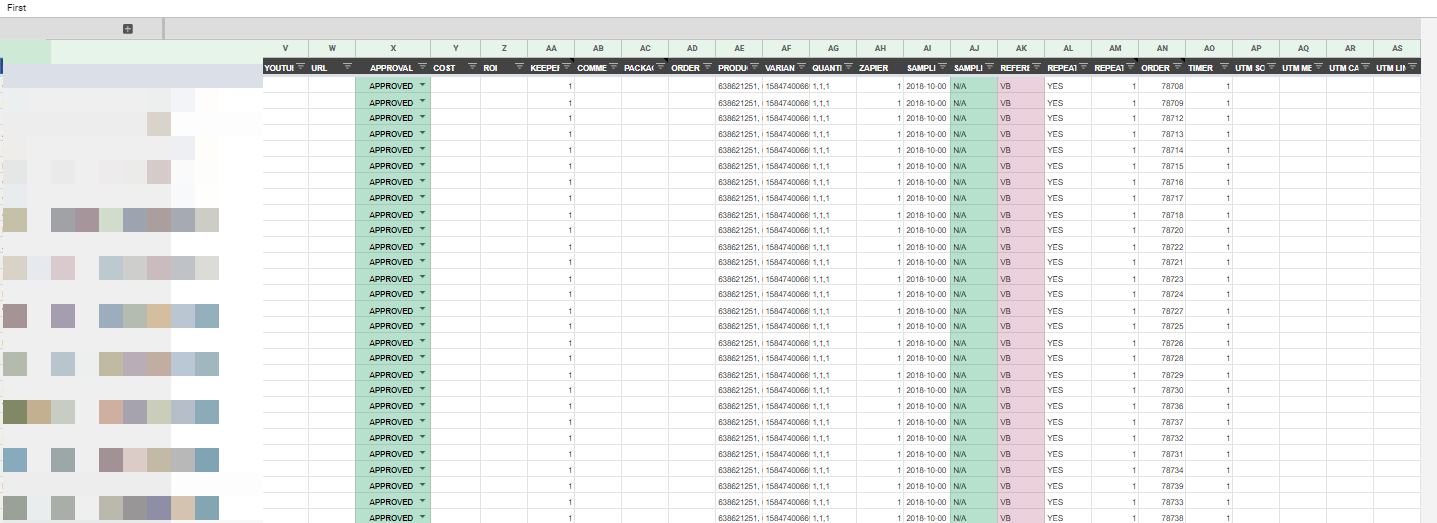
So, how did we do it?
First, you need to break the problem down to simpler parts.
Before diving in, let’s do some planning:
TL;DR
- Step 1: Setting goals
- Step 2: Finding influencers and vetting them
- Step 3: Pitching and negotiating influencers
- Step 4: Shipping product and track
- Step 5: Making your system better
Step 1: Setting Goals
Let’s face it, diving in without planning is a sure way to drop the ball. When managing any operation, the last thing you want happening is to lose your flow.
Determine the scope
Which countries do I want to target?
You have to ask yourself which regions you want to target. For instance, if you only ship to the USA and Canada, you can eliminate any influencers located in other countries.
Which platforms do I want to target?
Where do you want to focus your efforts? Is your brand more Instagram or Youtube worthy? In most cases, you would pitch influencers on both platforms.
But don’t stop there!
There are many other platforms where you can find influencers:
- Blogs (they give you a good SEO boost too)
- Twitch
- Reddit (be careful when playing with this one, there are a different set of social norms)
- Quora (Why not?)
- Etc. (Use your imagination)
Pro Tip
I recommend using Similar Web’s free Chrome extension for broader evaluation and ahrefs for organic reach. These tools will help you gauge the quality of a Quora thread, a blogger, or even a subreddit’s reach.
Let’s face it.
Influencers are simply people who receive attention from other people. What we’re buying from them is the attention. Treat them as humans (of course), but remember that you are purchasing media.
What is the cost of your product and how much does it cost to ship?
Always add the cost of your product and your shipping to your cost per influencer. This is common sense.
Here is some simple math to show my point and how it will affect your strategy:
Cost of your product + shipping + influencer fee = Cost per influencer
On the one hand, if your product + shipping cost is low (let’s say you’re a t-shirt brand), your cost per influencer will be controlled by the influencer’s fee.
Cost of product + Shipping cost + Influencer fee = Cost per influencer
3$ (t-shirt cost) + 5$ (shipping cost) + 200$ (influencer fee) = 208$
On the other hand, if your product is a mountain bike, it would completely change the dynamic of your strategy.
Cost of product + Shipping cost + Influencer fee = Cost per influencer
600$ (bike cost) + 300$ (shipping cost) + 200$ (influencer fee) = 1100$
This is simply something to think about–let’s move on!
What niches are relevant to your product?
If your product is a yoga mat, don’t complicate things; target the yoga niche.
On the other hand, if your product is a cell phone accessory, the world is yours. Any niche applies to you. Choose your targeting based on your current buyer demographics.
You can change these parameters as you test different markets and see which ones are better for you.
How many influencers do you want to close?
When we look at our numbers, we start a negotiation with roughly 25% of the influencers we pitch.
Ultimately, our closing rate depends on our client’s budget restrictions. We always aim for a 10% closing rate (this is the threshold we guarantee our clients when offering agency services).
Let’s look at a segment of a campaign we ran:
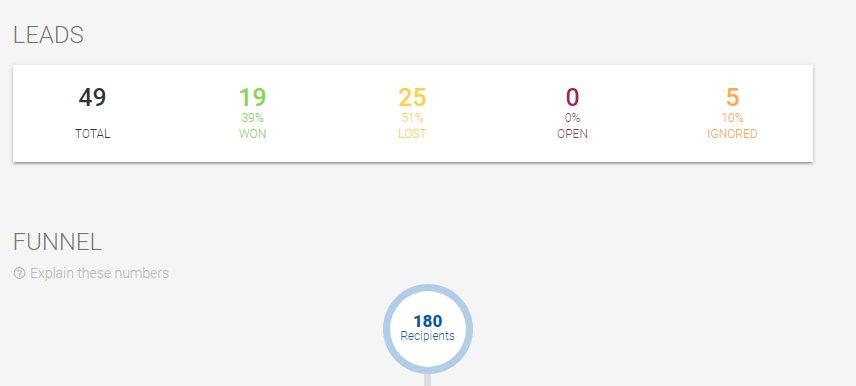
Let me explain what you see
- We’ve pitched 180 influencers in this batch.
- We negotiated with 44 leads. five of them were autoresponders (we probably had the wrong email addresses).
- We closed 19.
So, if you want 100+ influencers with these numbers, you would pitch 1000 influencers.
The more you pitch, the better your rates will become, and the more accurate your data will be. This is because you will continously tweak your process and pitches.
Always remember:
These numbers are dependent on 1) the niche you’re targeting, 2) the budget you’re willing to spend on each influencer and 3) the influencer’s reach
Step 2: Find influencers and vet them
I will show you the manual way to do this.
Feel free to set up your system using imacros (if you’re a non-developer) or create your Python script to automate this part of the process.
We’ve done this internally to save our team from burnout and preserve our Glassdoor rating.
Pro Tip
We are beta testing our database. If you’d like to have early access, just signup here and drop us a line.
So, let’s breakdown the steps:
- Finding keywords relevant to the influencers we’re targeting
- Searching Youtube for influencers using our targeted keywords
- Selecting influencers based on your base standards
- Organizing the data in Sheets (you can use Excel if you’re that type of person ;))
1. Building a keyword list
Using tools to create your seed list
There are a lot of tools out there to help you find keywords for your list.
Here is a list of tools you can use:
- Keywordtool.io
- Keyword.io
- Lsigraph.com
There are as many ways to build a keyword list as there are atoms in the universe.
Ok, maybe not…
We use this keyword tool to start our research. You will be fine with the free version of the backtesting software. This is simply to get your list flowing.
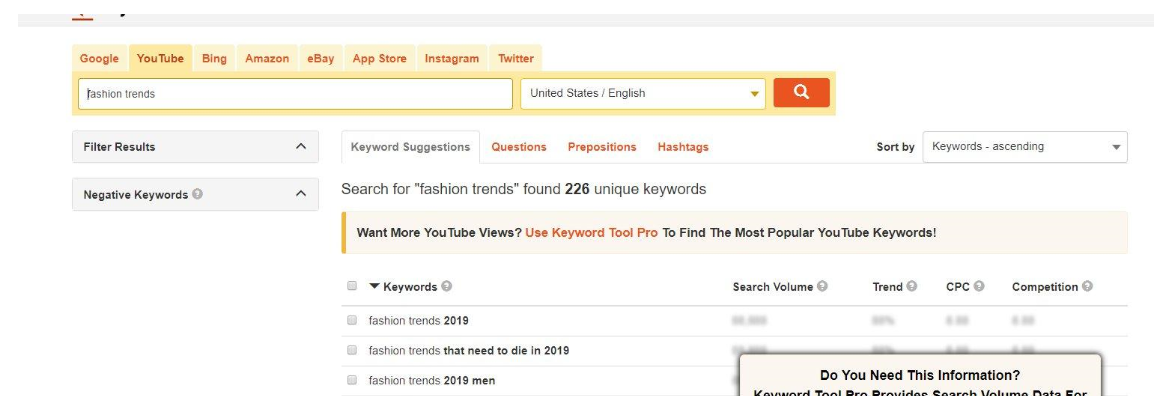
The best possible outcome is finding queries that will pull up multiple Youtubers. Select your keywords accordingly.
If you are unsure about the quality of a keyword, punch it into Youtube and see if it brings relevant results.
The more relevant results a keyword pulls, the less work you have to do.
Using Youtube Suggest to augment your keyword list
Youtube Suggest will allow you to find highly relevant keywords.

Pro Tip
I like using the Keywords Everywhere Chrome extension to speed up keyword picking (it’s free, you can get it here). Generally speaking, a keyword with a higher volume will pull more influencers.
Adding all your queries to Google Sheets
Now you have a relevant list!

You can start finding and vetting influencers. We use a mix of Virtual Assistants and our in-house scraping software to make this process efficient.
Run down the list and gather influencers with their relevant information.
Let’s dive into this part of the process!
2. Finding influencers
Before you or a virtual assistant go through your list of keywords and find tons of influencers, make sure you establish clear guidelines. This limits human input (aka fewer errors).
Here is a list of guidelines that have worked pretty well for us:
- The Youtuber has 5000 subscribers
- The Youtuber has posted more than ten times in the last year
- The Youtuber has 5000+ views on at least 6 of his previous ten videos
- The Youtuber is a person (not a media or a company)
- The Youtuber is in Canada or USA
After you have set this, go to Upwork and hire a virtual assistant to accomplish this task or do it yourself. Make sure to build an easy to understand workflow and get your team rolling.

3. Automating the process
This workflow is time intensive, to say the least. It generates us 25 qualified influencers for every 60 minutes of work.
So, let’s say you would want to close 100 influencers. Taking into consideration a closing rate of 15%, you would need to prospect 667 Youtubers.
You would roughly need 27 hours (667 / 25) of work to get this result, excluding the relation management work.
We have built our internal scraper to reduce this workload. We are currently working on a usable version of the tool. If that’s of interest to you, you can signup here and drop us a line!
Step 3: Pitching and Negotiating Influencers
Pitching influencers in bulk
The best way to approach this problem is by treating it like a sales problem. You will find all the dynamics of a typical sales process.
I can tell you that the sales cycle is very short because our interests are closely aligned. Influencers want money and/or free stuff, and we want visibility and endorsement.
We use Mailshake to manage list cleaning, bulk outreach, and negotiation. It is an excellent tool for short sales cycles (SEO link building and influencer outreach, for example).
A Little More About Mailshake
Mailshake is a robust tool that allows you to manage relations at scale. On top of that, they manage unsubscribes and list cleaning for you. This means that you will not be pitching bad email addresses, thus reducing your bounce rate and your spam score.
Pros:
- Very easy to setup and use.
- It is very light-weight and does its job very well
- Allows you to use templates efficiently
- Easily create follow-up logic
- Integrates with Zapier, which allows you to automate this part of the process efficiently
Cons:
- You will need to set up other parts of your workflow. This tool is not an all-in-one solution. If this is not an issue for you, then this tool will be perfect.
Negotiating Influencers
Some influencers will be lowballing while others will be highballing. That’s how humans are.
Here is one piece of advice that will always serve you well:
Always negotiate
They ask for 40, you offer 20. They ask for 1000, you offer 300. This is a reflex that will significantly impact your bottom line.
Pro Tip
The niche you are pitching is to be considered when considering the price you should pay. I like to gather 40-50 responses before I set my quantitative benchmarks on the rate we’re willing to pay.
I recommend you set your price using the following metrics: average video view (exclude viral videos that can inflate drastically this metric) and average engagement ( (likes + dislikes + comments) / views)
What about subscribers?
Subscribers are a filtering metric, but we never use it to measure the price we’re willing to pay. After all, we’re after visibility and endorsement. These two goals are directly reflected in the two metrics mentioned previously.
Things to take into consideration
This is not an exact science and will require you to make some judgment calls. Questions you will come across are:
- What if the influencer makes a dedicated video for my product?
- Can I reuse the content in my other campaigns?
- Will the Youtuber share my content on other social media channels?
How to manage these considerations
We look for influencers that have the potential to become ambassadors of our brands. So if a Youtuber is charging 500USD and we judge that there is potential for future collaboration and their metrics are close to what we’re willing to pay, we will usually take the risk.
I know I told you to limit human input as much as possible, but sometimes you can’t get away from it.
This part of our system requires human input. As your knowledge of a niche deepens, you will develop an intuition of what’s worth it and what’s not.
You will close some bad deals, and you can’t hide from that.
Step 4: Shipping Product and tracking results
When an influencer is closed, you ship the product. There are two ways to do this: manually or automatically.
Doing it manually
This implies that you create a PO through your e-commerce platform each time an influencer agrees to your conditions.
Let me say something…
These are daunting tasks:
- Data crunching the influencer’s data into our platform
- Checking to validate we sent the right product and we entered the correct address
- Sending an email telling them the whole process has been done and that we will be waiting on their content for approval.
Seems straight forward, I know. But, when you grind it 100 times, it gets to you.
I would not recommend this way of doing, unless you are playing around with influencer marketing. It has a high potential for error, and it will create hair pulling amongst your team!
Doing it automagically
Welcome to the future!
We now have all these non-dev friendly tools that make us feel like geniuses (I’m looking at you Zapier).
You can automate your entire influencer fulfillment process, Even if you can’t write a line of code.
This part of the process will require a combination of 3 tools:
- Google Forms (or any other form tool)
- Zapier
- Google Sheets (My favorite tool of all time)
Here is what your standard process will look like:
Youtuber accepts negotiation > send form > Form is filled out > Google Sheets > Youtuber is vetted > Zapier > PO > Email
1. Send the form
When a Youtuber accepts our negotiation, our outreach manager will send the form. This form will ask questions such as:
- What is your name?
- What is your email?
- What is your address?
- What is your Youtube channel?
- What is your Instagram?
- Which product do you want (visual selection)?
- Make sure to format your shipping fields to match your e-comm platform
Here is an example:
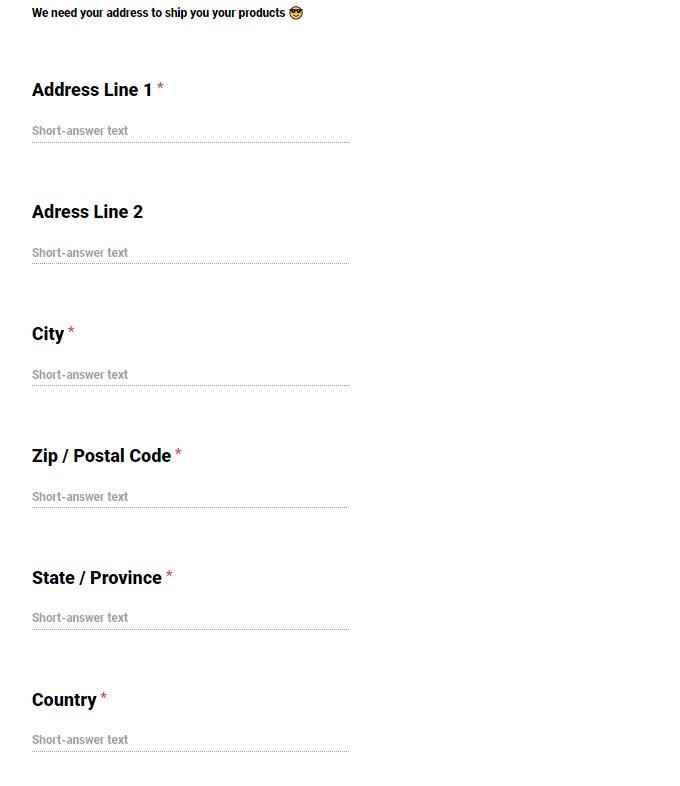
This allows us to have the data properly formatted when it enters our Google Sheets.
2. Convert your form info to PO friendly data in Google Sheets
You want to convert your data to a format your e-commerce platform will understand. This allows your Sheets and your e-comm platform to communicate via Zapier.
There are two ways to do this:
- Pass the data in the proper format from the form to Sheets. This will not always be possible, depending on your form tool and the user’s inputs.
- Alter the data directly in Google Sheets using formulas. This method allows you to remove accents from letters such as é or change the user’s input to a product id. Using formulas is reasonably simple, but if you want to dive deep into the concepts, you can go here: https://codingisforlosers.com/google-sheets/
Zapier allows you to create a listener. It follows this logic: IF String “Yes” is found in column X, send PO to e-commerce platform. This allows you to quickly glance and approve all of the influencers you’ll be shipping to. I recommend this last checkup, especially when you have multiple people running the operation. It acts as a safety net for your brand (and your wallet).
It is an out-of-the-box integration that shouldn’t take you more than 30 minutes.

3. Send a follow-up email telling the Youtuber his order has been shipped
You can do this by setting an email tool on top of your Zapier (i.e. Mailgun) or you can plug it into your existing system, without routing through Zapier. This is a decision you will take based on your current setup.
4. Approve the content and track the results
We always ask our influencers to send us the content before they publish it. It is a crucial part to protect your brand identity.
To make this simple, make it a payment condition. If the Youtuber is unapproving of this way of doing business, offer him/her half of the payment upfront and half the payment after approval.
When you are dealing with more significant Youtube accounts, I suggest you implement a contract signing software into your process. I recommend using docusign.com.
We also require the Youtuber to send us a live link when the content goes live. Add this link to your Google Sheets and track your results from there.
Step 5: Constantly Hacking Your System
Constantly hacking your influencer factory is a crucial component to achieving disproportionate success.
Determine your benchmark metrics and improve upon those.
Make it a mission to improve on your key campaign metrics. It will drive continuous improvement across your team.
Here are some of ours:
- Vetted influencers per hour
- Email open rate
- Email answer rate
- Negotiation time per influencer (time spent negotiating and nurturing relation/number of influencers closed)
The best way to improve on these metrics is to run continuous testing.
Let me breakdown how we continuously improve on each of these components:
Vetted influencers per hour
This is one we’ve tackled head-on by building our own Youtube parser. We hypothesized that having a parser would kill our vetting time considerably (which is quite apparent).
We realized that there are A LOT of terrible Youtube channels. Our parser was returning a lot of junk. This forced us to vet the list of results we received manually.
What happened next?
It actually turned out to be extremely efficient (roughly 200 per hour) — Our production time to 12.5% of our original run rate. Not too bad of an ROI, I can tell you that.
We then decided to build a database with all the Youtubers we found. We now run a continuous channel scrape to keep our data up to date (subscribers, views, comments, etc.) and voilà! We’ve developed an edge that allows us to pitch new influencers efficiently for any new client (in case you missed it, we’re opening up our database for beta. You can signup here and drop us a line).
The Flywheel Effect
Keeping a database of Youtubers allows us to build a flywheel. In other words, the more clients we onboard, the better our data is, and the easier our service is to fulfill.
Email Open Rate
This metric is quite tricky.
Why?
Because gaming your email subject line by adding “RE:” at the beginning will increase the metric’s performance, but will drastically decrease your email answer rate. This is why we use this metric by playing with two parameters:
- Deliverability. If you’re getting an open rate of 8%, I recommend you test your email deliverability using this tool. It is free and will give you actionable insights on how to improve your deliverability.
- Attention Grabbing. We alter our headlines to grab your attention without deceiving our end user. You can read this article if you want more info on converting headlines.
If you’re using Mailshake, you will have mountains of data on which headlines are performing best for your niche. You will also be able to A/B test headlines, which will provide you fascinating insights.
Email answer rate
Your answer rate can be impacted by 1) tweaking the body of your email and 2) your follow-up sequences. Of course, your headline can play on this too, which is why I recommend isolating one variable in one niche at a time.
Our secret sauce?
Out-of-the-box thinking pays here.
Here is an example of our 4th email sequence:

It has increased our closing rate drastically. Of course, you will get messages such as this:

But you will also get messages such as:
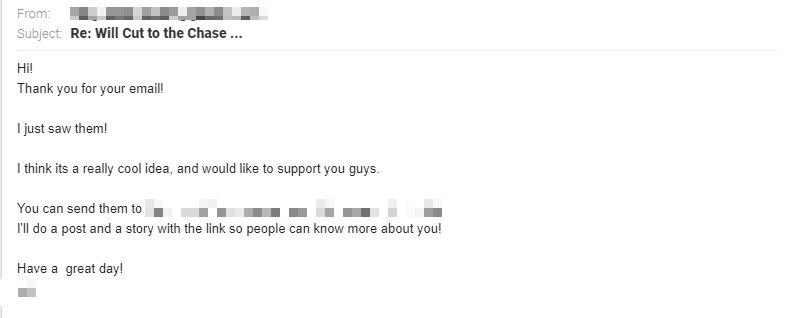
Playing around with your templates will influence the number of influencers you close substantially. This step profoundly impacts your bottom line of influencers closed (given that all your emails are not going to the spam box).
Wrapping it up
We went through a complete system to pitch and manage hundreds of influencers.
This system is built on four key components:
- Finding influencers and vetting them
- Managing orders and approving content
- Tracking results
- Continuously improving the output
The key to any successful operation is to measure the output and improve on the right metrics. If you keep going in that direction, you will have an influencer marketing machine that performs like a source of paid traffic.
How can you leverage this to the maximum?
- You identify your top performing influencers
- You create a long-term partnership with them
- You send them your new product releases
- You advertise using their audiences
- Keep innovating!
This allows you to drive constant sales from influencer marketing.